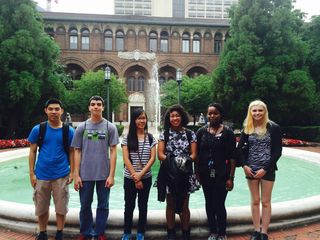 Back in 2013, the Penn Medicine News Blog covered then rising high school junior Kareema Dixon, who started her science career, in part, by participating in the BioEYES program developed by Jamie Shuda, EdD, director of Life Science Outreach at the Institute for Regenerative Medicine (IRM). Dixon continued with her research on the effects of oil on zebrafish development, which she wrote up for a research paper for her International Baccalaureate Diploma, a two-year advanced educational program some high schools offer. After graduating this spring from Bodine High in Philadelphia, she will attend Drexel University in September to major in Biomedical Engineering. This summer, however, she was back at Penn -- one of six high school students working in Perelman School of Medicine labs as part of an IRM six-week internship:
Back in 2013, the Penn Medicine News Blog covered then rising high school junior Kareema Dixon, who started her science career, in part, by participating in the BioEYES program developed by Jamie Shuda, EdD, director of Life Science Outreach at the Institute for Regenerative Medicine (IRM). Dixon continued with her research on the effects of oil on zebrafish development, which she wrote up for a research paper for her International Baccalaureate Diploma, a two-year advanced educational program some high schools offer. After graduating this spring from Bodine High in Philadelphia, she will attend Drexel University in September to major in Biomedical Engineering. This summer, however, she was back at Penn -- one of six high school students working in Perelman School of Medicine labs as part of an IRM six-week internship:
- Amber Headrick, 17, MaST Community Charter School. Amber worked with mechanosensory neurons in mice with Wenqin Luo, MD, PhD in the department of Neuroscience.
- Andrew Yaravoi, 16, Julia R. Masterman High School. Andrew worked with induced pluripotent stem cells with Paul Gadue, PhD, from The Children’s Hospital of Philadelphia.
- Kareema Dixon, 18, Bodine High School. Kareema worked with induced pluripotent stem cells with Jeannette Bennicelli, PhD, at the Penn Center for Advanced Retinal and Ocular Therapeutics.
- Queenie Lam, 18, Girard Academic Music Program. Queenie studied early vertebrate development with Peter Klein, MD, PhD, in the department of Cell and Developmental Biology.
- Kemi Oladuja, 17, Timbercreek Regional High School. Kemi is studied epigenetic memory in ants with Roberto Bonasio, PhD, in the department of Cell and Developmental Biology.
- Timothy Yu, 18, Concordia International School in Shanghai. Tim genotyped zebrafish with Mary Mullins, PhD in the department of Cell and Developmental Biology.
Shuda noted that the internship program, newly reinstated by IRM director Ken Zaret, PhD, was a huge success and that two mentees have already inquired about staying on during the school year and next summer. “We asked them all to write reflection papers at the end of the program, in which they all said they will remember this experience for the rest of their career,” she said. “They were accepted into their labs and expected to attend regular lab meetings, held accountable for their work, and many conducted experiments that most researchers are not exposed to until they are graduate students.”
Indeed, Dixon loved the diverse training and mentoring she was exposed to: “One day we transfected cells and did hemocytometer counting; another day we conducted a Western Blot, another day we did cDNA reverse transcriptase, and another day we synthesized proteins.” She also cherished the camaraderie that some labs have: “Although everyone in the lab is independent, they are also a big family and I love that!”
Lam loved the independence she gained after becoming familiar with her lab: “The second to last week of the internship, my mentor had to leave for a conference. I was put in the care of the PI of the lab. I enjoyed getting the ‘grad student research experience’ because it put me in the shoes of a potential career and education path I might take in the future. I learned through my own mistakes and learned how to fix them on my own.”
Lam also thrived on the hands-on approach of an intense lab mentorship: “It is completely different learning in a classroom about double helix DNA than it is to interact directly with DNA. It will definitely help me in my future biology classes in college.”
From the investigators perspective, Mullins says that it was an excellent opportunity for graduate student Ben Tajer in her lab to supervise Timothy Yu. “Clearly they both gained a lot by the experience, Timothy in working with zebrafish and learning molecular biology techniques and Ben in gaining experience in mentoring. Timothy also helped move Ben's project forward.”
In other IRM summer program news, the Penn Academy for Reproductive Sciences, a six-day research clinic for high school girls, was featured in the National Research Council's Division of Behavioral and Social Sciences and Education committee report on informal science learning as a premier example of bridging classroom content with real world applications.
Earlier this summer and last summer many other high school and undergrad student programs were featured on this blog. Given the positive experience the 2015 IRM interns and others said they took away from their summer experience at Penn, these will be the mentors of the future to watch out for, and they got their start right here in Penn Medicine labs.
Photo, from left to right: Tim Yu, Andrew Yaravoi, Queenie Lam, Kemi Oladuja, Kareema Dixon, and Amber Headrick.